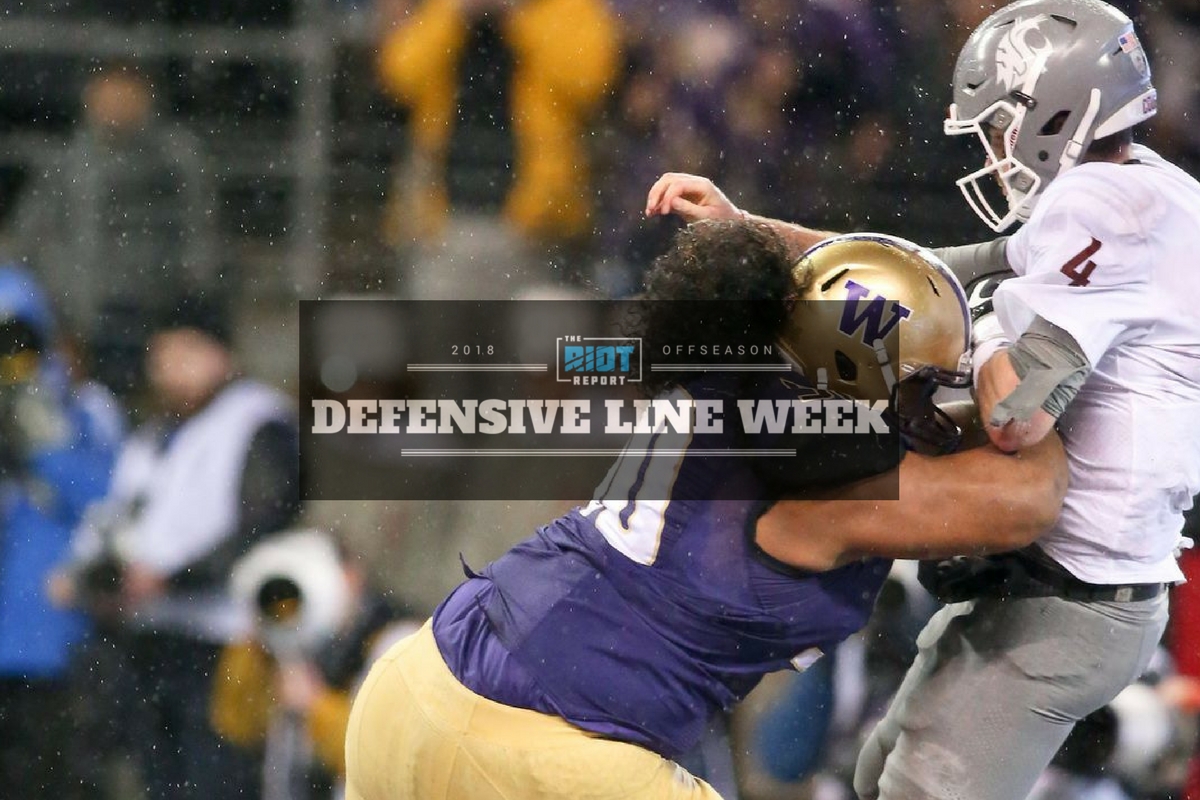Each week this offseason, we’ll be focusing on one position and how the Panthers may choose to address their needs; whether they’re in the market for an upgrade at starter or just a reliable backup, every player on the 53-man roster is going to be important in 2018.
This is Defensive Line Week.
Nose tackle is far from the Panthers’ biggest concern this offseason, especially given the recent signing of Dontari Poe; however, sometimes a player is simply too good to pass on, what with “Best Player Available” and drafting for strength and all that. While it is highly unlikely that Vita Vea falls as far as 24, if he is there it would be hard for the Panthers to talk themselves out of taking him. However, as with Vernon Butler two years ago, sometimes players do fall further than expected and Butler was possibly mocked as going even higher than Vea; so what would make Vea so hard to pass over?
The Power And The Glory
At 6’4 and 347 pounds, Vea is not just a large man, he’s an enormous one, and delivers every bit of power that a man of his frame should. He seemed more than capable of driving blockers back in the run game, such as on plays like the following:
This strength not only allows him to drive blockers backwards but also enables him to anchor against the run and push the pocket in the passing game; for most nose tackles that is enough, but what makes Vea so special is his quickness. Despite injuring his hamstring, Vea was still able to manage a 5.11 40-yard dash at the Combine and had reportedly been running sub-5.0 during training pre-tweak. The only player of his stature to have put up numbers of that type is Dontari Poe, one of the best, if not the best, pass-rushing nose tackles in the NFL. This quickness might not stand out quite so much on tape, but for a nose tackle to move this way is extremely rare:
This speed separates Vea from historic prospects such as Danny Shelton, to whom he is often compared, but as with almost all positions, nose tackles cannot survive on athleticism alone, luckily Vea has a lot of technique to go with his.
Run Defense
For nose tackles, everything has to start with their ability to defend the run, as this is where the core of their value lies. For Vea, he was asked to work from both 3-4 and 4-3 fronts at Washington and his run defense was not just effective but versatile. Most commonly, he was asked to anchor against the blocker while maintaining gap discipline and then, when relevant, disengage and make the tackle.
What Vea does well here is that he is able to use his strength to hold his ground, but is still able to have the awareness to maintain his gap and follow the ball carrier. This allows him to disengage, albeit partially, to make the tackle on the ball carrier. This is not something that all nose tackles can do as it requires both good awareness and the hand usage to be in a position to be able to disengage in this way; where Vea really stand out, however, is in his ability to fully disengage when necessary.
On these plays, Vea shows a classic stack-and-shed move, where he gets under the guards pads, drives him upwards, and then rips him down and sideways which allows Vea to either disengage or force the hold. This move requires both strong hands and a good pad level to drive the guard upwards; if this move fails, Vea occasionally showed the ability to simply throw blockers aside, whether he will still be able to do this at the NFL level is unknown, but the strength required to do this is absurd:
Another way in which Vea was used at Washington was as a gap penetrator; this is especially valuable on outside runs where it allows the defense to force the play back inside to the waiting pursuers.
Again, this makes use not only of Vea’s quickness but also the good pad level which prevents the guard from being able to get underneath him and drive him up and away. Vea even showed the ability to disengage on the backside of outside runs and chase the play down from the back:
Based on this, it should hardly be surprising that teams often looked to direct double-teams his way, and while NFL guards will be better, he will likely experience this at the next level as well. Taking on double teams is really the primary role of nose tackles in many schemes, as it allows for more space for the linebackers behind him to make plays; while Vea was sometimes caught a little high by such double teams, he generally showed a good pad level allowing him to use his strength to anchor:
It is impossible to tell how an NFL offense will attempt to block him, but Vea’s strength, pad level and hand usage will likely make it all but impossible for NFL guards to handle him one-on-one.



